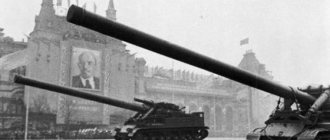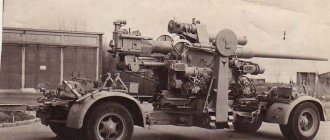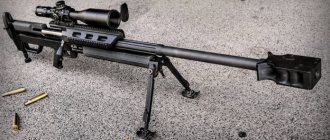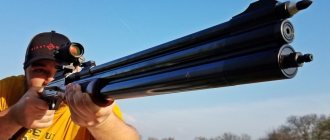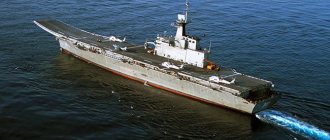In the movies, the hero fired almost from the hip, and the enemy on the other side of the world fell motionless. In life, the laws of cinema do not work, but the force of gravity, the force of wind and other nuances of ballistics do, which stubbornly prevent you from shooting as far and accurately as possible. We have selected five of the coolest rifles of all time that can hit a target at a distance of two kilometers or even more.
Mortar "Oka"
In fifth position on the list of the world's largest guns is another domestic development of the Soviet era - the Oka mortar. In the middle of the last century, the USSR already had nuclear weapons, but experienced some problems with delivering them to the target location. Therefore, Soviet designers were given the task of creating a mortar that could fire nuclear warheads.
As a result, they got a kind of monster with a caliber of 420 mm and a weight of almost 60 tons. The mortar's firing range varied within 50 kilometers, which, in principle, was sufficient for mobile tank equipment of those times.
Despite the theoretical success of the enterprise, mass production of Oka was abandoned. The reason for this was the monstrous recoil of the gun, which negated all mobility: for a normal shot it was necessary to properly dig in the mortar and build supports, and this required too much time.
Howitzer "Saint-Chamond"
The French long-range railway howitzer also had very impressive characteristics. Its caliber of 400 mm and projectile weight of 641 kg do not seem so huge in comparison with the German “Karl”, however, “Saint-Chamon” had an undeniable advantage in firing range. This parameter reached 17 kilometers. Even in our time, not every artillery piece is capable of throwing a projectile over such a long distance, whereas for this gun, created back in the 19th century (1884), this task was quite feasible.
An old drawing depicting “Lazy Metta”. The weapon itself has not survived
Ultra-long range or ultra-altitude?
Already in the mid-1930s, ultra-long-range guns had a serious competitor in the form of missiles. A number of experts admitted that talk about rockets being developed to transport mail or interplanetary communications is in fact just a cover for military work, the results of which could “fundamentally change the methods of combat operations.” French engineer L. Damblian, for example, proposed a design for a ballistic missile with an inclined launch from an artillery gun and a flight range of up to 140 km. In Germany, since 1936, work had already been carried out on a ballistic missile with a flight range of up to 275 km. Since 1937, at the Peenemünde test center, the A4 rocket, which became better known to the world under the name “V-2,” was perfected.
On the other hand, enthusiasts of interplanetary communications did not abandon the “artillery” ideas of Jules Verne. In the 1920s, German scientists M. Vallier and G. Oberth proposed firing a projectile towards the Moon, building for this purpose a giant cannon with a barrel length of 900 m on the top of a mountain near the equator. Another pioneer of astronautics proposed his own version of the “space gun” in 1928 G. von Pirke. In both cases, of course, things didn’t go beyond sketches and calculations.
There was another tempting direction for achieving super-ranges and super-heights - replacing the energy of powder gases with electromagnetic energy. But the implementation difficulties turned out to be much greater than the expected benefits. The “magnetic-fugal” gun of the Russian engineers Podolsky and Yampolsky with a theoretical flight range of up to 300 km (proposed back in 1915), the solenoid guns of the French Fachon and Viglione, and the “electric guns” of Maleval did not go beyond the drawings. The idea of electromagnetic guns is still alive today, but even the most promising railgun designs still remain just experimental laboratory installations. The fate of research instruments was also reserved for “super-high-speed” light-gas guns (their initial projectile speed reaches 5 km/s instead of the usual 1.5 for “powder” guns).
"Big Bertha"
Another weapon of German designers, but from the beginning of the last century, when the First World War was raging. The gun was developed at the already mentioned Krupp plant in 1914. The gun received a main combat caliber of 420 mm, and each individual projectile weighed almost one ton. Having a firing range of 14 kilometers, such indicators were quite acceptable.
"Big Bertha" was designed to destroy particularly strong enemy fortifications. Initially, the gun was stationary, but after some time it was modified and made possible to use on a mobile platform. The first option weighed about 50 tons, and the second about 40. To transport the guns, steam tractors were used, which with great difficulty, but coped with their task.
At the landing site of the projectile, a deep depression with a diameter of up to 15 meters was formed, depending on the ammunition chosen. The gun's rate of fire was surprisingly high - one shot in eight minutes. The cannon was a real disaster and a headache for the allies. The machine not only inspired fear, but also demolished even the strongest walls and fortifications.
But despite its destructive power, "Big Bertha" was vulnerable to enemy artillery. The latter was more mobile and quicker of fire. During the assault on the Osowiec fortress, in eastern Poland, the Germans, although they pretty much battered the fort, lost two of their guns. While the Russian soldiers repelled the onslaught with great success, damaging only one standard artillery unit (the naval "Kane").
Faule Mette ("Lazy Mette")
“Lazy Metta” is a weapon of impressive caliber, which consumed about 30 kilograms of gunpowder per shot. This cannon, designed to fire stone cannonballs, was created at the beginning of the 15th century by workers under the guidance of master Henning Bussenschutte. Due to the fact that not a single gun has survived to this day, we can only state its approximate characteristics: caliber - 67-80 cm, weight - 9 tons, shot weight - up to 430 kg. Perhaps it was not the largest cannon of those years, but it looked like a very serious trump card during the siege of fortified positions.
German gun "Big Bertha" on a mobile carriage
The longest-range gun in the world
As the editors of the Popular Mechanics portal reports with reference to Defense News, the head of the US Army program for the development of long-range weapons, Colonel John Rafferty, reports that the technology by which the gun will be manufactured is truly innovative. However, a number of experts are still not sure about the economic feasibility of such a project.
The United States Army is set to test a key technical component at the Dahlgren Naval Support Facility in Virginia "very soon." For obvious reasons, the tactical and technical characteristics of the new weapon are not disclosed to us. Moreover, what is noteworthy is that at the moment the longest-range guns in service with the US Army are capable of hitting a target located at a distance of up to 265 nautical miles. However, apparently, we are talking about a cannon that fires rocket-propelled ammunition. The military already had similar developments, but it never got to the point of testing prototypes.
Conventional artillery pieces operate by using an artillery shell propelled by a gunpowder charge. When firing a cannon, burning powder gases create enormous pressure. The pressure itself grows and, reaching a “critical point,” throws the cartridge out of the gun. Here everything should be somewhat different. The new "Big Gun" will fire rocket-propelled projectiles (RAP).
The prototype of one of the most famous big guns in the USA. Photo from 1990
Can a long-range cannon be used for naval needs? Quite possible. Now the US Army is in full swing testing railgun guns (or railguns). But no matter how powerful they are, their charges are unlikely to be able to cover a distance of 1800-1900 kilometers. Another argument in favor of the feasibility of this project is the cost of charges for railguns. Each of them costs 400 to 500 thousand US dollars to produce, which is significantly more expensive than even “ordinary” rocket-propelled projectiles. What do you think about such a powerful gun?
The United States Army hopes to have a prototype gun ready by 2023. Until this point, all key elements of the gun will be tested. In particular, the projectile launch system, as well as systems for adjusting the accuracy of the gun at such long distances, are of greatest interest at the moment. Whether the projectiles will be guided is currently unknown.
Modern salvo systems
The leader of artillery pieces today is the Russian Tornado gun. The caliber of the projectile is 122 mm and is fired at a distance of up to 100 thousand meters. Fires up to 40 charges in one salvo. The area covers up to eighty-four thousand square meters. High chassis reliability. The speed of the Russian gun is 60 kilometers per hour. Covers distances of 650 kilometers. All these characteristics of the weapon allow it to be transferred to the desired location in a fairly short period of time.
In second place of honor in terms of efficiency are the Russian 9K51 Grad MLRS. Has 40 barrels. The caliber of the projectile is 122 mm. The gun's firing range is up to twenty-one thousand meters. In one salvo, it “covers” up to 40 thousand square meters of area. The Grad's speed is up to 85 kilometers per hour. At maximum speed, the installation covers a distance of one and a half thousand kilometers.
The third position was rightfully occupied by the HIMARS artillery gun, produced by American specialists, due to its technical characteristics. The caliber of the 227 mm projectile is literally impressive. But only six projectile guides spoil this impression. Firing range up to 85 thousand meters. One salvo of this weapon, manufactured in the USA, covers an area of 67 thousand square meters. The gun reaches speeds of up to 85 kilometers per hour. HIMARS can cover a distance of 600 kilometers. This artillery piece has proven itself very well in ground operations conducted by the American government in Afghanistan.
The WS-1B gun, which was produced in the Middle Kingdom, was not included in the top three and only took fourth position. The caliber of this 320 mm gun is terrifying. Has four barrels. Firing range - up to 100 thousand meters. The affected area is up to 45 thousand square meters. The power reserve at a maximum speed of up to 85 kilometers per hour is 600 kilometers.
Fifth place went to the Indian Pinaka MLRS installation. The caliber of the projectile is 122 mm, there are twelve guides. The gun's firing range is up to 40 thousand meters. The maximum speed of movement reaches 85 kilometers per hour. And the affected area is up to 130 thousand square meters. This weapon was developed jointly with specialists from Russia. It has proven itself well on the battlefield in the Indian-Pakistani conflicts.
Railgun: escape velocity for a projectile
Despite the fact that the Malka is one of the most powerful guns in the world, artillery technology does not stand still. Soon, a weapon operating on fundamentally new physical principles may appear in the world. The publication “War and Fatherland” once spoke in detail about this device. We are talking about the announced American invention, the railgun. According to the influential American newspaper The Wall Street Journal, this weapon, which is an electromagnetic gun, is capable of sending a projectile at the first and second cosmic velocities. Such technical characteristics are certainly impressive. The only alarming fact is that there is a lot of talk about this weapon, although it is only at the development stage. So, it is not clear when it will appear in the Pentagon’s arsenal. At the same time, Russia recently successfully tested a gun similar in operating principle in Shatura at the Laboratory of Pulsed Energy Effects on Matter. The gun showed the ability to impart a projectile speed reaching 11 km/s. At the same time, Russian researchers emphasize that their weapon was not created for killing their own kind, but for space research. It should be noted that in the modern world, artillery pieces are used mainly for tactical purposes. When it is necessary to hit an enemy at a long distance, rocket technology is used. The golden age of artillery, when engineers competed to create guns capable of sending shells over enormous distances, occurred during the First and Second World Wars. At that time, truly unique types of artillery were created. Moreover, the Germans have succeeded more than others in this matter.
Tsar Cannon
This legendary weapon needs no introduction. The Tsar Cannon was cast in bronze in 1586 by the talented master Andrei Chokhov.
The characteristics of the Tsar Cannon are impressive: caliber - 890 mm, length - 5.34 meters, weight - 40 tons. Anyone can view this impressive beauty when visiting the Moscow Kremlin.
Both the carriage and the cannon itself are covered with skillfully made patterns, and there are also various inscriptions on them. Experts claim that this weapon was originally made as a combat weapon - at least one shot was fired from it, however, no documentary evidence of this has been found. The Tsar Cannon is rightfully in the Guinness Book of Records.
German "Dora". Just getting this monster into position for firing was a serious engineering challenge.
"Malka": blossoming "Peony"
At the end of 2022, in Russia, according to RIA Novosti, the modernization of one of the most powerful guns in the world today, the Peony, was successfully completed. After a number of innovations, the weapon received a new name - “Malka”. According to the management of Uraltransmash, serial production of these artillery systems will begin in the country next year. The official name of the gun is SAU2 S7 M “Malka”. Moreover, despite the fact that the gun is considered new, its first development entered service back in 1975, and in 1983 the gun underwent its first modernization. Since then, the 203 mm gun has been constantly improved, trying not to lose the title of one of the most powerful in the world. "Malka" is designed to destroy potential enemy targets located at the tactical depth of defense behind the front line. This weapon is capable of firing both high-explosive fragmentation and active-rocket projectiles. But the main feature of the gun is the ability to fire concrete-piercing, chemical and nuclear charges. This makes the Malka a formidable and indispensable type of weapon in the modern theater of military operations.
Accuracy International AW50
The British Accuracy International did not play tricks with the new cartridge, but developed the AW50 rifle for the powerful and proven .50BMG cartridge. The main task of the weapon is not to defeat living targets, but to destroy the enemy’s material assets, for which a more powerful cartridge is ideal. The maximum sighting range of the weapon is 2000 meters, the bolt is longitudinally sliding and rotary, like most modern rifles. When firing, ammunition is supplied from detachable box magazines (five rounds each).
Due to the use of the more powerful .50BMG cartridge, the British had to make changes to the basic design of the rifle. In particular, some parts are made not of steel, but of titanium alloy. In addition, engineers have applied a number of solutions to compensate for recoil: there is a compensator in the muzzle of the barrel, which reduces the bounce of the barrel when fired, and an additional bipod, a “third leg,” is installed under the butt.
"Little David"
This gun from the United States is a legacy of World War II and is considered the world's largest cannon in terms of caliber diameter. “Little David” was developed as a tool for eliminating particularly powerful enemy structures on the Pacific coast.
But the gun was not destined to leave the training ground where it was successfully tested, so the gun inspired fear and respect only in photographs of the foreign press.
Before firing, the barrel was mounted on a special metal frame, which was buried a quarter into the ground. The cannon fired non-standard cone-shaped projectiles, the weight of which could reach one and a half tons. At the site of the explosion of such ammunition there was a deep depression 4 meters deep and 10-15 meters in circumference.
Self-propelled mortar "Karl" (Gerät 040)
One of the heaviest and most powerful weapons ever used on the battlefield is the Karl mortar, used during World War II. With a caliber of 600 mm, its shells weighed from 1250 to 2170 kg, having a dead weight of 126 tons. According to the original plan, such self-propelled mortars were supposed to assist troops in destroying the fortifications of the enemy army, primarily the fortifications of the Maginot Line. It was not possible to use them in the conflict with France, and these large installations made their debut only during the attack on the Brest Fortress and the shelling of Sevastopol. Subsequently, Soviet troops managed to capture one of these mortars, and today it can be seen in the museum of armored vehicles in Kubinka, near Moscow.
Another museum exhibit is the “Mad Greta” bombard.
"Big Bertha": Queen of the First World War
The Germans became famous for the creation of giant artillery pieces during the First World War. In 1914, at the factories of the Krupp family, in honor of one of the representatives of the family of German arms magnates, a huge mortar was produced. The gun had a caliber of 420 mm and could fire a projectile weighing 900 kg at a distance of 14 kilometers every eight minutes. When it exploded, a crater with a diameter of 10 meters and a depth of up to 4 meters was formed. The gun itself looked quite impressive. At the same time, Bertha Krupp, after whom this weapon was named, was also a woman of very impressive size. But she not only was not offended by such a name, but was also proud that her name personified the most powerful artillery weapon of those years. In battle, “Big Bertha” proved herself to be the best. Its use on the Western Front allowed the Germans to easily take fortresses and destroy Allied fortifications and forts. However, it was not only the “Big Bertha” that became famous for the range and power of its shells during the First World War. A German cannon with the long and mysterious name “Kaiser Wilhelm Trumpet,” also produced at the Krupp factories, also caused significant damage to Paris. The gun could hit a range of 130 kilometers, a record for those years, with a projectile weight of 120 kg. Parisians were stunned when 21 artillery shells fell on the French capital on March 21, 1918, despite the fact that there were no enemy troops near the city. The unique gun had a caliber of 210 mm with a barrel length of 28 meters with an additional six-meter extension. Externally, the gun looked like a huge metal monster, weighed 256 tons and was placed on a special railway platform. The flight altitude of the projectile reached 45 km, becoming a complete surprise for the enemy. True, the Germans were unable to use the Kaiser Wilhelm Trumpet to the maximum extent possible. The fact is that the gun barrel could only withstand 65 shots, after which it had to be replaced, which was extremely expensive and irrational.
"Mad Greta" (Dulle Griet)
Bombarda was created in the 14th century in the town of Ghent, which at that time was located on the territory of the Holy Roman Empire. The gun barrel was welded from 32 forged strips connected by 41 hoops. “Greta” had impressive dimensions for its time: length – 5 meters, caliber – 660 mm, weight – 16 tons. Stone cannonballs were used as projectiles.
French heavy gun "Saint-Chamond". Installation on a railway platform significantly increases artillery mobility
Idea-fix
However, the idea of an ultra-long-range gun fell into fertile soil. Already in 1918, the French built the so-called “response cannon” of the same caliber - 210 mm with a barrel length of 110 calibers. Its projectile weighing 108 kg with an initial speed of 1,450 m/s was supposed to fly 115 km. The installation was mounted on a 24-axle railway conveyor with the ability to fire directly from the track. This was the heyday of railway artillery, the only one capable of quickly maneuvering guns of high and special power (then vehicles and the roads along which they moved could not even compete with railway communications)... The French, however, did not take into account the fact that the “response gun” Not a single bridge can withstand it.
Meanwhile, the Italian at the end of 1918 designed a 200-mm cannon with an initial projectile speed of about 1,500 m/s and a firing range of 140 km. The British, in turn, hoped to hit targets on the continent from their island. To do this, they developed a 203-mm cannon with an initial velocity of 109-kg projectile of 1,500 m/s and a range of up to 110-120 km, but did not implement the project.
Already in the early 1920s, French and German experts substantiated the need to have a gun of about 200 mm caliber with a firing range of up to 200 km. Such a gun was supposed to fire at strategically important and preferably (due to the dispersion of hits) area targets. These could be enemy concentration areas, administrative and industrial centers, ports, and railway junctions. Opponents of superguns reasonably noted that bomber aircraft could easily solve the same problems. To which supporters of ultra-long-range artillery responded that guns, unlike aviation, can hit targets around the clock and in any weather. In addition, with the advent of military aviation, air defense systems were born, and neither fighters nor anti-aircraft guns could interfere with the ultra-long-range cannon. The advent of long-range, high-altitude reconnaissance aircraft and the development of ballistic calculation methods gave hope for increasing the accuracy of ultra-long-range shooting, due to more accurate information about the coordinates of the target and the ability to adjust shooting. Since the number and rate of fire of such guns were small, there was no talk of “massive” shelling. The most important factor in this case was considered to be the psychological factor, the ability to keep the enemy on edge with the threat of surprise attacks.
Methods for increasing the firing range are well known - increasing the initial velocity of the projectile, selecting the elevation angle, improving the aerodynamic shape of the projectile. To increase speed, the propellant powder charge was increased: for ultra-long-range shooting, it had to be 1.5-2 times heavier than the projectile. So that the powder gases can do more work, the barrel is lengthened. And to increase the average pressure in the barrel bore, which determines the speed of the projectile, progressively burning powders were used (in them, as the grain burns out, the surface engulfed in flame increases, which increases the rate of formation of powder gases). Changing the shape of the projectile - lengthening the head part, narrowing the tail - was intended to improve its streamlining with air flow. But at the same time, the useful volume and power of the projectile decreased. In addition, speed losses due to air resistance can be reduced by increasing the lateral load, that is, the ratio of the mass of the projectile to the area of its largest cross-section. In other words, the projectile in this case must be lengthened. At the same time, it was necessary to guarantee its stability in flight by ensuring a high rotation speed. There were other specific problems. In particular, in long-range guns, conventional copper leading belts of projectiles often could not withstand very high pressure and could not “guide” the projectile correctly along the rifling of the barrel. We remembered the polygonal (in the shape of an oblong prism twisted with a screw) shells that Whitworth experimented with in the 1860s. After World War I, the prominent French artilleryman Charbonnier transformed this idea into projectiles with ready-made projections (“rifled”), the shape of which followed the rifling of the bore. Experiments with polygonal and “rifled” projectiles have begun in a number of countries. The projectile could be lengthened to 6-10 calibers, and since the energy consumption for forcing and friction was less than with leading belts, it was possible to obtain longer ranges even with heavier projectiles. In the second half of the 1930s, it was considered quite probable “that in the near future guns with a caliber of 500-600 mm, firing at a distance of 120-150 km, will appear.” At the same time, towed guns with a firing range of up to 30 km and railway guns with a range of up to 60 km were simply considered “long-range”.
"Basilica" or Ottoman cannon
"Basilica" was a real miracle of technology for its time. It was made by the Hungarian master Urban in the 15th century, commissioned by Sultan Mehmed II. The gun had gigantic dimensions for its time: length - 12 meters, large caliber - 75-90 cm, weight - 30 tons. To move this bronze giant, 30 bulls were required. To service the gun, its crew included at least 250 people. The firing range is 2 kilometers, which is very good for the fifteenth century.
“Basilica” is a cannon that is not remarkable for its gigantic size. With the help of this weapon, the Ottoman artillery managed to make a hole in the previously impregnable walls of Constantinople, which helped capture the city. The fall of Constantinople led to the final collapse of the Byzantine Empire.
It should be noted that “Basilica” did not fight for long. The cannon barrel could not cope with the enormous loads, and as it was fired, it became covered with more and more cracks. A few weeks after the start of use, the gun became completely unsuitable for firing. But this in no way diminishes its colossal historical significance.
